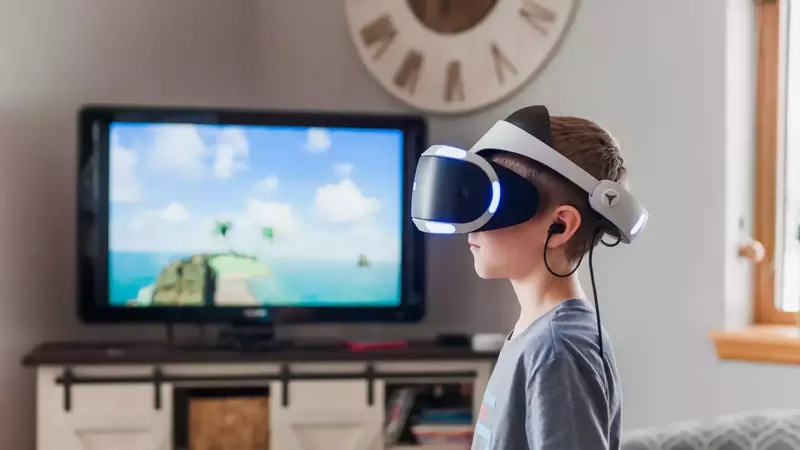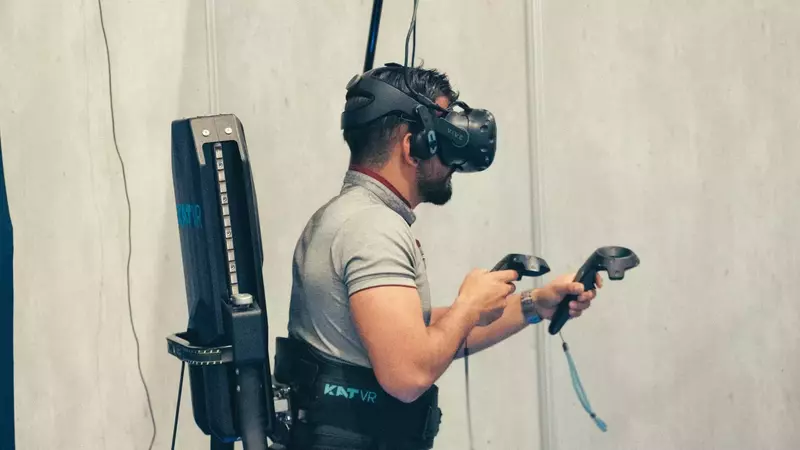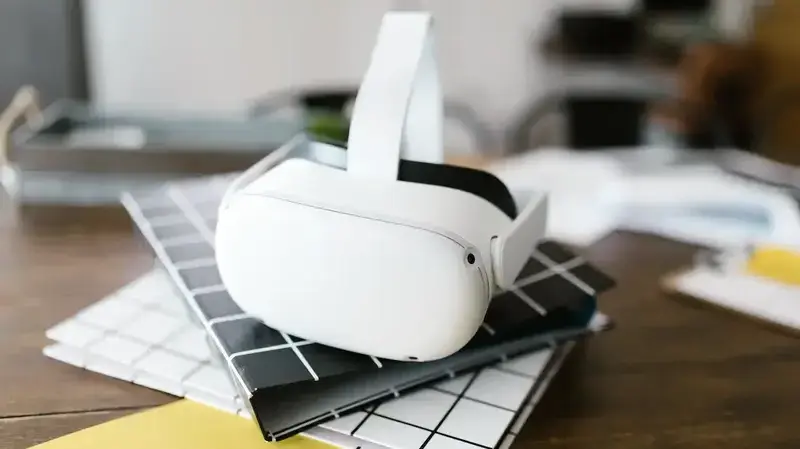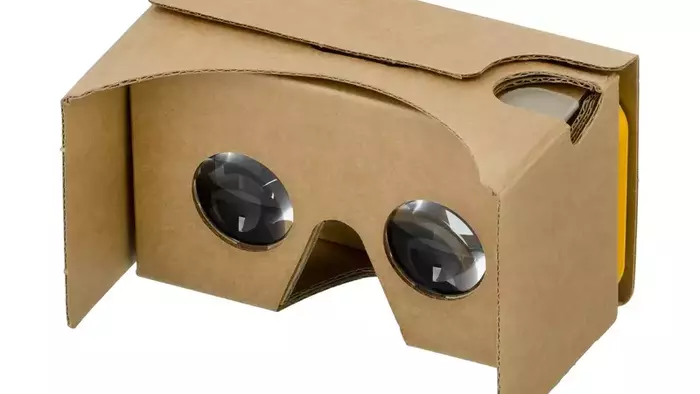This site contains affiliate links to products, and we may receive a commission for purchases made through these links.
As the world of technology continues to evolve, one question that often arises is, “what is VR and how does it work?” Virtual reality (VR) has become a popular topic among gamers, explorers, and those seeking immersive experiences. In this blog post, we will dive deep into the fascinating realm of virtual reality.
We’ll explore the different types of VR systems available today and discuss their benefits in various applications. Additionally, we’ll address some challenges faced by users while engaging with virtual environments.
In conclusion, we will examine the potential of virtual reality as it rapidly advances. Grasping the fundamentals of VR and its functions can help us to recognize its possible effects on our lives.

What is Virtual Reality?
Virtual reality (VR) is an immersive technology that transports users into a computer-generated environment, allowing them to interact with and explore their surroundings in real-time.
By simulating the user’s senses of sight, sound, and sometimes touch, VR creates a convincing illusion of being present within a virtual world.
The concept of virtual reality has been around for decades but has gained significant popularity in recent years due to advancements in hardware and software technologies.
A HMD is the key component of any VR system, featuring sensors to track head movements and screens that provide stereoscopic images for each eye to enable users to experience depth perception and 360-degree visuals as they move.
This combination enables users to experience depth perception and 360-degree visuals as they move their heads naturally.
Spatial audio technology is used in many VR systems to offer a realistic auditory experience, with sound effects adjusted based on the user’s position within the virtual world.
Some advanced setups even include haptic feedback devices like gloves or vests that simulate tactile sensations such as touch or impact.
A Brief History of Virtual Reality
- 1960s: The first functional HMD was developed by Ivan Sutherland called “The Sword of Damocles.”
- 1980s: Jaron Lanier coined the term “virtual reality” and founded VPL Research, which developed early VR hardware like the DataGlove.
- 1990s: Sega and Nintendo attempted to bring VR gaming to consumers with products like Sega VR and Virtual Boy, but both were commercial failures due to technical limitations.
- 2010s: The Oculus Rift Kickstarter campaign sparked a resurgence of interest in virtual reality technology. Major tech companies such as Google, Sony, HTC, and Facebook entered the market with their own headsets.
The rapid evolution of virtual reality has led to a diverse range of applications beyond gaming.
Today’s users can explore new worlds through immersive storytelling experiences or even learn valuable skills using interactive training simulations.
As this groundbreaking tech advances quickly, it has the potential to drastically alter how we come into contact with digital material in our daily lives.
Immersing oneself in a simulated environment, users are able to explore and interact with the virtual reality. Gaining comprehension of the diverse forms of virtual reality helps us comprehend its operations and potential applications.
Virtual reality (VR) is an immersive technology that creates a convincing illusion of being present within a computer-generated environment. Headgear with sensors to trace the user’s head movements and dual screens displaying stereoscopic visuals for each eye is an essential component of any VR system. Recent technological progressions have made VR a widely adopted technology, allowing for its use in applications such as interactive training simulations and immersive storytelling experiences beyond gaming.
Types of Virtual Reality
As virtual reality technology has advanced, a wide range of immersive experiences have become available to users. There are several types of virtual reality systems available today, each with its unique features and capabilities.
In this section, we will explore some popular types of VR technologies:
a) Tethered VR Headsets

Tethered VR headsets, such as the Oculus Rift S and HTC Vive Pro, require a connection to a powerful gaming PC or console via cables.
These high-end devices provide an impressive level of immersion thanks to their advanced tracking systems and high-quality graphics rendering capabilities.
b) Standalone VR Headsets

Standalone headsets like the Oculus Quest 2 and HTC Vive Focus Plus do not need any external hardware connections as they come equipped with built-in processors, storage space, and sensors for motion tracking.
Although these devices may not offer the same graphical fidelity as tethered options, they provide more freedom in terms of movement due to their wireless nature.
c) Smartphone-based VR Systems

Note: This type is becoming less common due to advancements in standalone headset technology.
In smartphone-based virtual reality systems like Google Cardboard or Samsung Gear VR (No longer supported by Samsung since 2023), users insert their smartphones into a headset, which serves as the display and processing unit.
Though cheaper than dedicated VR sets, these smartphone-based systems often offer limited capability and a lower quality experience in comparison to other virtual reality devices.
d) Augmented Reality (AR) Headsets
Although not strictly considered virtual reality, augmented reality headsets like Microsoft HoloLens or Magic Leap 1 also provide immersive experiences by overlaying digital content onto the user’s real-world environment.
These devices often include advanced sensors for spatial mapping and gesture recognition, allowing users to interact with both physical objects and digital elements seamlessly.
In short, numerous VR solutions are accessible today that can meet various requirements and preferences. Whether you’re looking for an affordable entry-level option or seeking high-end immersion in your gaming sessions, there’s likely a VR system out there that will suit your requirements.
Different types of VR may span from complete immersion through headsets to augmented reality, providing users access to a broad selection of virtual environments.
To gain the most out of these technologies, it is necessary to comprehend their workings. In the next section we will discuss the various Benefits of Virtual Reality.
VR has advanced over time, delivering an immersive experience to users. There are several types of VR systems available today, including tethered and standalone headsets as well as smartphone-based and augmented reality systems. Each type of VR system offers distinct advantages and features to suit varied requirements and tastes.
Benefits of Virtual Reality
VR has seen a surge in popularity due to its many advantages, making it an appealing option for various activities, from gaming to exploration and education.
This immersive technology offers a wide range of benefits that can enhance various aspects of our lives, from gaming to exploration and learning.
Beneath this, we will explore the various advantages that virtual reality technology offers.
a) Enhanced Gaming Experience
One major advantage of VR is the unparalleled gaming experience it provides.
By submerging gamers in a completely immersive 3D landscape, VR games offer an unparalleled level of involvement and enthusiasm when compared to conventional video games.
Players can feel as if they are truly part of the game world, making for more memorable experiences and heightened emotional responses.
b) Immersive Exploration
Virtual reality provides an avenue for users to traverse real or imaginary environments without ever having to leave their homes.
With applications like Google Street View VR, people can virtually travel across the globe or visit famous landmarks right from their living rooms.
This is an ideal solution for those who cannot physically travel due to financial constraints or physical limitations.
c) Educational Opportunities
- Interactive Learning: Virtual reality enables students to learn by doing rather than simply reading about concepts or watching videos on a screen. For example, medical students could practice surgeries within a realistic simulation before performing them on actual patients – improving their skills while minimizing risk.
- Cultural Understanding: VR can also be used to promote cultural understanding and empathy by allowing users to experience life from different perspectives. Projects like Within offer immersive documentaries that place viewers in the shoes of people from various backgrounds, fostering a deeper appreciation for diverse cultures.
- Special Needs Education: Virtual reality has proven particularly beneficial for students with special needs, as it allows them to engage with educational content in ways tailored specifically to their individual requirements. For instance, children on the autism spectrum may find it easier to learn social skills through VR simulations designed explicitly for their unique learning styles.
In summary, virtual reality offers numerous benefits across various aspects of our lives – enhancing gaming experiences, enabling immersive exploration opportunities and providing innovative educational tools.
As technology progresses, we can anticipate a broad range of stimulating advancements in the domain of virtual reality.
The potential of virtual reality is clear, enabling users to traverse novel realms and intensify their encounters. Despite these advantages, there are some challenges associated with using VR that must be taken into account when considering its use.
VR affords a range of advantages, from more captivating gaming encounters to immersive exploration possibilities and imaginative educational applications. VR allows users to learn by doing rather than simply reading or watching videos on a screen, making it particularly beneficial for students with special needs. As technology continues to advance rapidly, we can expect even more exciting developments within the realm of virtual reality.
Challenges with Virtual Reality
While virtual reality (VR) offers numerous benefits, it also comes with its own set of challenges that need to be addressed in order to ensure a seamless and enjoyable experience for users.
In this section, we will discuss some of the most common issues faced by VR enthusiasts and explore possible solutions.
A. Motion Sickness
Motion sickness is one of the primary concerns when using VR technology, as it can cause discomfort or even nausea in some users.
This occurs due to a mismatch between what our eyes perceive and how our body interprets movement, leading to feelings of disorientation or dizziness.
To combat motion sickness, developers are constantly working on improving motion tracking systems and designing experiences that minimize abrupt movements.
B. High Cost of Entry
The expense of acquiring high-grade VR hardware can be excessively expensive for numerous potential users.
While there are more affordable options available, like Google Cardboard or Samsung Gear VR, these devices often lack the advanced features found in premium headsets such as Oculus Rift or HTC Vive Pro Eye, which offer superior immersion levels through better visuals and audio quality.
Comparing different types of headsets before making a purchase decision can help you find an option within your budget without compromising too much on performance.
C. Limited Content Availability
- Gaming: Although there has been significant growth in the number of games developed specifically for virtual reality platforms over recent years, their overall availability still pales compared to traditional gaming titles.
- Non-gaming applications: While there are numerous non-gaming VR experiences available, such as educational tools and virtual tours, the selection remains limited compared to other forms of digital content.
For VR technology to reach its highest potential, developers must create captivating and varied content that will attract a variety of people.
The good news is that many major tech companies like Facebook have committed significant resources towards developing new VR experiences.
D. Technical Limitations
The current generation of virtual reality hardware still has some technical limitations that can impact user experience. These include issues related to resolution, field-of-view (FOV), and latency.
As technology progresses, it is anticipated that these issues will be addressed in forthcoming VR devices to create more immersive and lifelike experiences for users.
E. Social Isolation Concerns
A common criticism leveled against virtual reality is its potential contribution towards social isolation by encouraging individuals to spend extended periods immersed in solitary digital worlds rather than interacting with others face-to-face.
However, recent advancements in multiplayer gaming platforms like Rec Room, which allow users from around the world to connect virtually through shared spaces within games or apps, are helping address this concern by fostering social interaction within a virtual environment.
Despite the obstacles, virtual reality remains a thrilling tech that will continue to develop and refine. As we contemplate the potential of virtual reality, novel applications for its use in various fields come to light.
VR offers many potential advantages, however there are still obstacles to be overcome. Motion sickness, high cost of entry, limited content availability, technical limitations and social isolation concerns are some of the issues that need to be addressed for a seamless and enjoyable VR experience. Developers are working on solutions such as improving motion tracking systems and designing experiences that minimize abrupt movements while creating diverse and engaging content to appeal to a wide range of users.
Future of Virtual Reality
The future of virtual reality (VR) is an exciting and rapidly evolving landscape, with advancements in technology and new applications being developed constantly.
As the utilization of VR becomes increasingly prevalent, more imaginative ways to use this immersive technology are being created.
A. Improved Hardware and Software
One major area where we will likely see significant improvements is in the hardware and software that powers VR experiences. This includes lighter headsets with higher resolution displays, better motion tracking systems, and more powerful processors capable of rendering realistic graphics at high frame rates.
These enhancements will make VR experiences even more immersive than they are today.
B. Expansion into New Industries
Virtual reality has been mainly utilized in gaming, however its potential is being realized by other industries as well. For example:
- Healthcare: Medical professionals are using VR simulations for training purposes or as part of therapy sessions for patients suffering from various conditions such as PTSD or phobias.
- Educational Institutions: Schools and universities have started incorporating VR into their curriculums to provide students with hands-on learning experiences that would be difficult or impossible to achieve otherwise.
- Tourism: Travelers can explore destinations virtually before booking a trip, giving them a taste of what they’ll experience when they arrive on location.
C. Social Interaction within Virtual Worlds
In addition to industry-specific applications, one key aspect of the future of virtual reality is its potential to facilitate social interaction within virtual environments.
As platforms like Facebook Horizon and VRChat continue to gain traction, we can expect more opportunities for users to connect with others in shared digital spaces, creating new communities and fostering collaboration on a global scale.
D. Integration with Augmented Reality (AR)
The line between VR and augmented reality (AR) will likely blur as these technologies become more advanced and intertwined.
We may see hybrid devices that allow users to switch seamlessly between fully immersive VR experiences and AR overlays on the real world, opening up even more possibilities for how we interact with both digital content and our physical surroundings.
As technology advances, virtual reality presents boundless possibilities for those seeking immersive experiences in gaming and professional applications.
From gaming enthusiasts seeking unparalleled immersion to professionals utilizing VR for training or therapeutic purposes, this rapidly evolving landscape offers exciting opportunities just waiting to be explored.
Promising prospects lie ahead for virtual reality, with developments in both hardware and software enabling its integration into healthcare, education, tourism and more. Social interaction within virtual worlds will be facilitated by platforms like Facebook Horizon and VRChat while the line between VR and AR will blur with hybrid devices that allow users to switch seamlessly between fully immersive experiences.
Frequently Asked Questions What is Vr and How Does it Work
What is VR and how does it work?
Virtual Reality (VR) is a simulated environment created by computer technology, allowing users to experience an immersive, 3D world. It works by using headsets that track the user’s head movements and display images accordingly, while controllers capture hand motions for interaction within the virtual space.
How do you explain VR to someone?
VR can be explained as a digital simulation that immerses users in a three-dimensional environment. By wearing specialized equipment like headsets and gloves, people can see, hear, and interact with this artificial world as if they were physically present there.
What is VR and why is it important?
VR stands for Virtual Reality – a technology that creates immersive experiences simulating real or imagined environments. Its importance lies in its potential applications across various industries such as gaming, education, healthcare, training simulations and architectural design visualization among others.
How does VR experience work?
A VR experience works through devices like headsets or goggles equipped with sensors tracking your movement. These devices render 360-degree visuals of the virtual environment based on your position & orientation. Paired with audio systems & haptic feedback devices like gloves or vests provide sensory input making interactions feel more realistic.
!! For more information about the different VR headsets on the market, check out this product specification list.
Conclusion
Virtual Reality is an immersive technology that allows users to experience a computer-generated environment. This blog post explored the different types of VR, including fully-immersive and non-immersive experiences.
We also discussed the benefits of VR, such as its ability to enhance education and training programs, as well as some challenges it faces, like motion sickness.
In conclusion, Virtual Reality is an exciting technology with many potential applications in gaming, education, healthcare and more.
As we continue to develop new hardware and software solutions for VR systems, we can expect even greater advancements in this field in the future.
If you’re interested in learning more about Virtual Reality or exploring how it could benefit your business or organization’s goals then visit Pursuit Meta. Our experienced professionals can provide assistance in incorporating VR into your plans.

Espen
Espen is the Director of PursuitMeta and has written extensively about Virtual Reality and VR Headsets for years. He is a consumer product expert and has personally tested VR Headsets for the last decade.





Leave a Reply